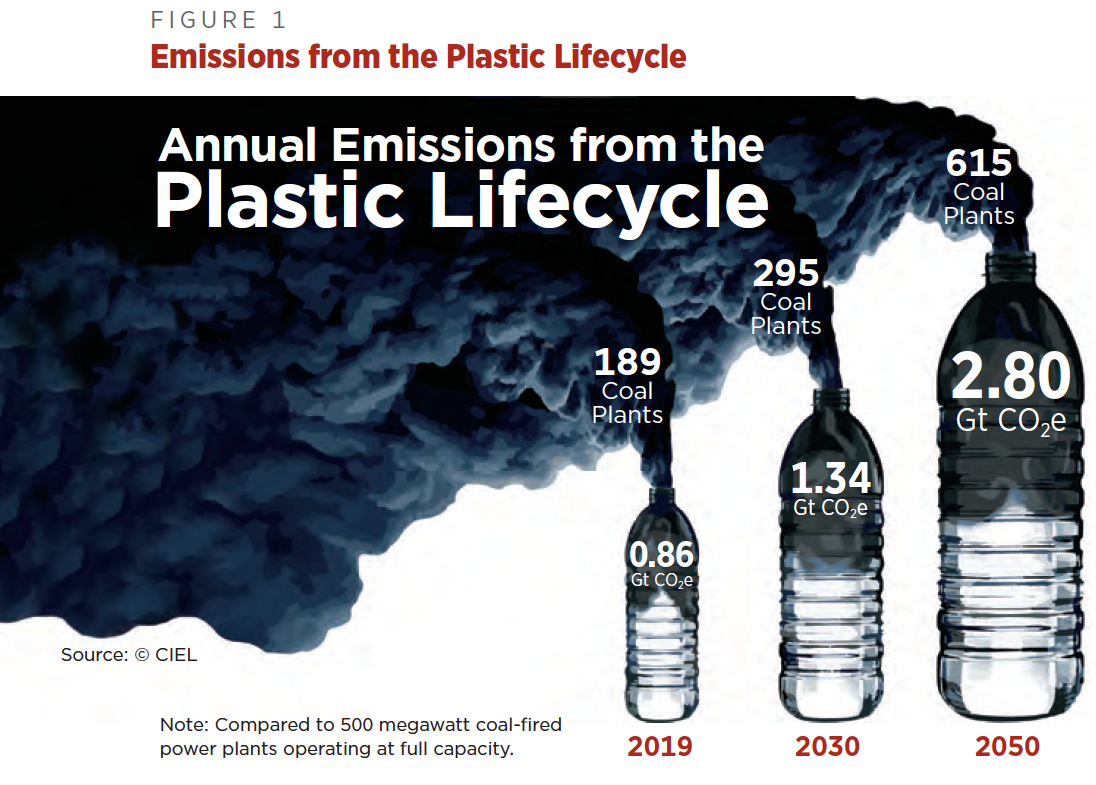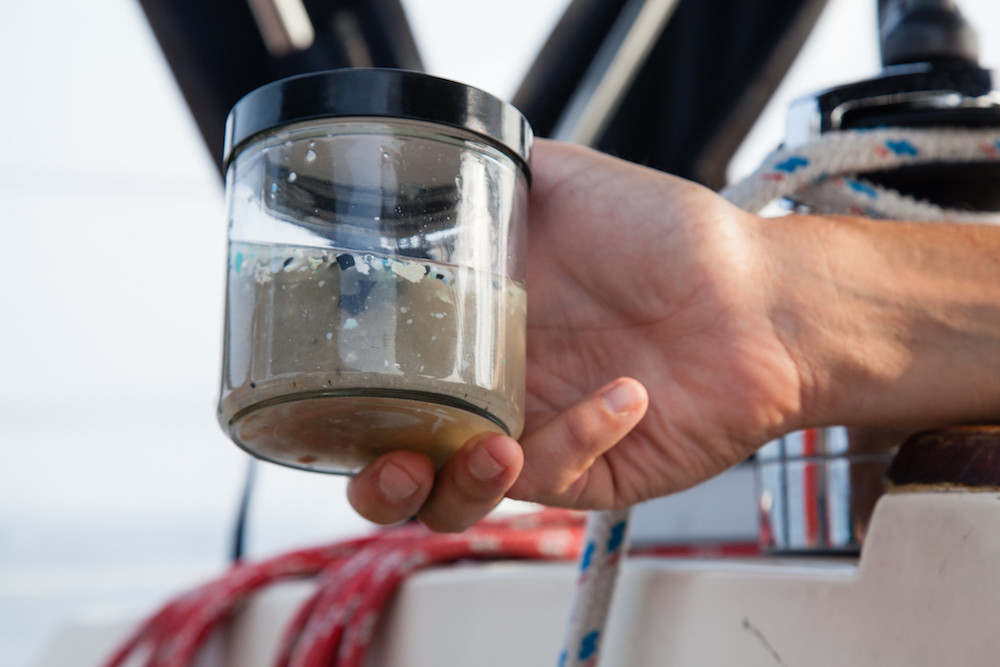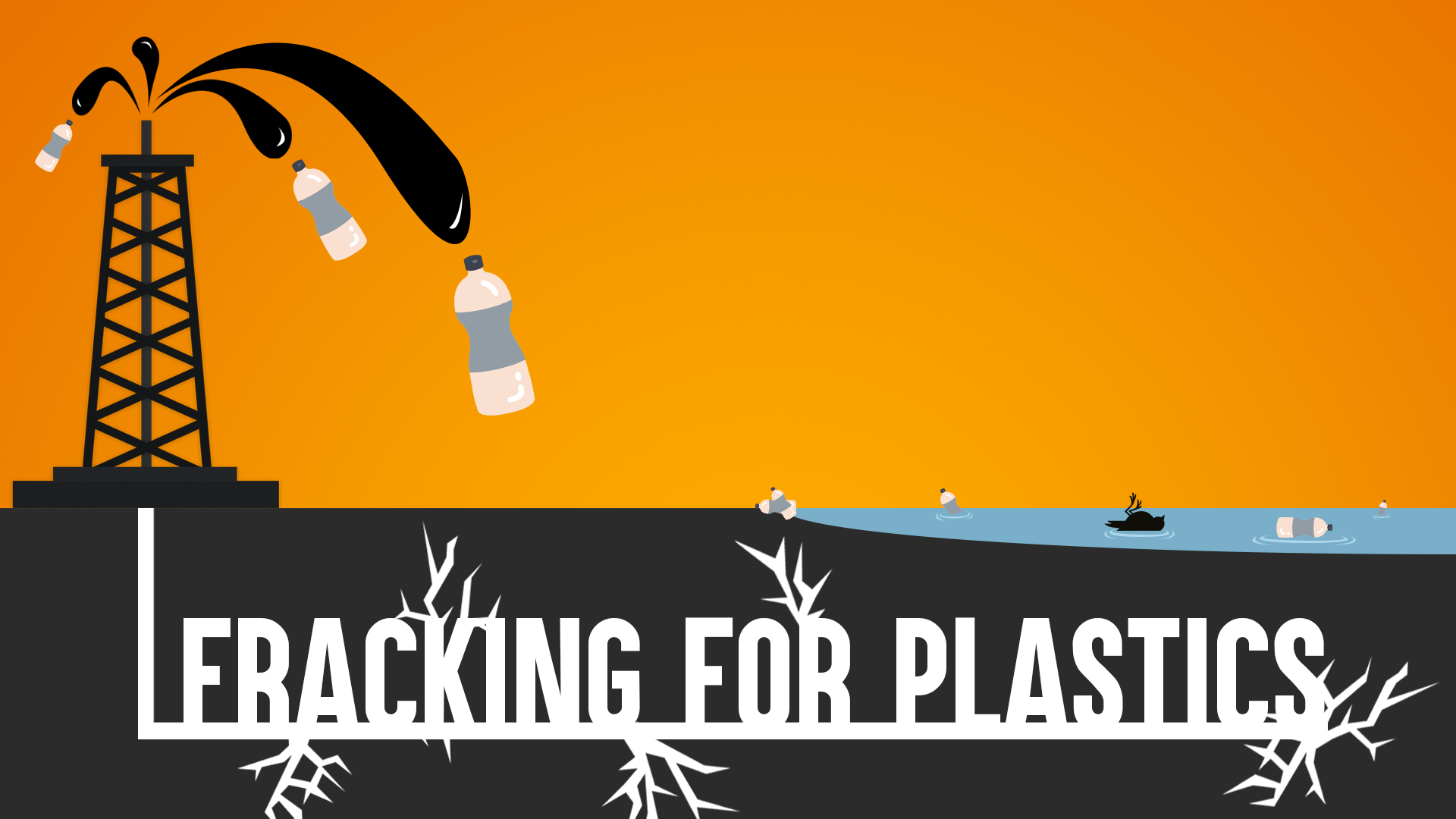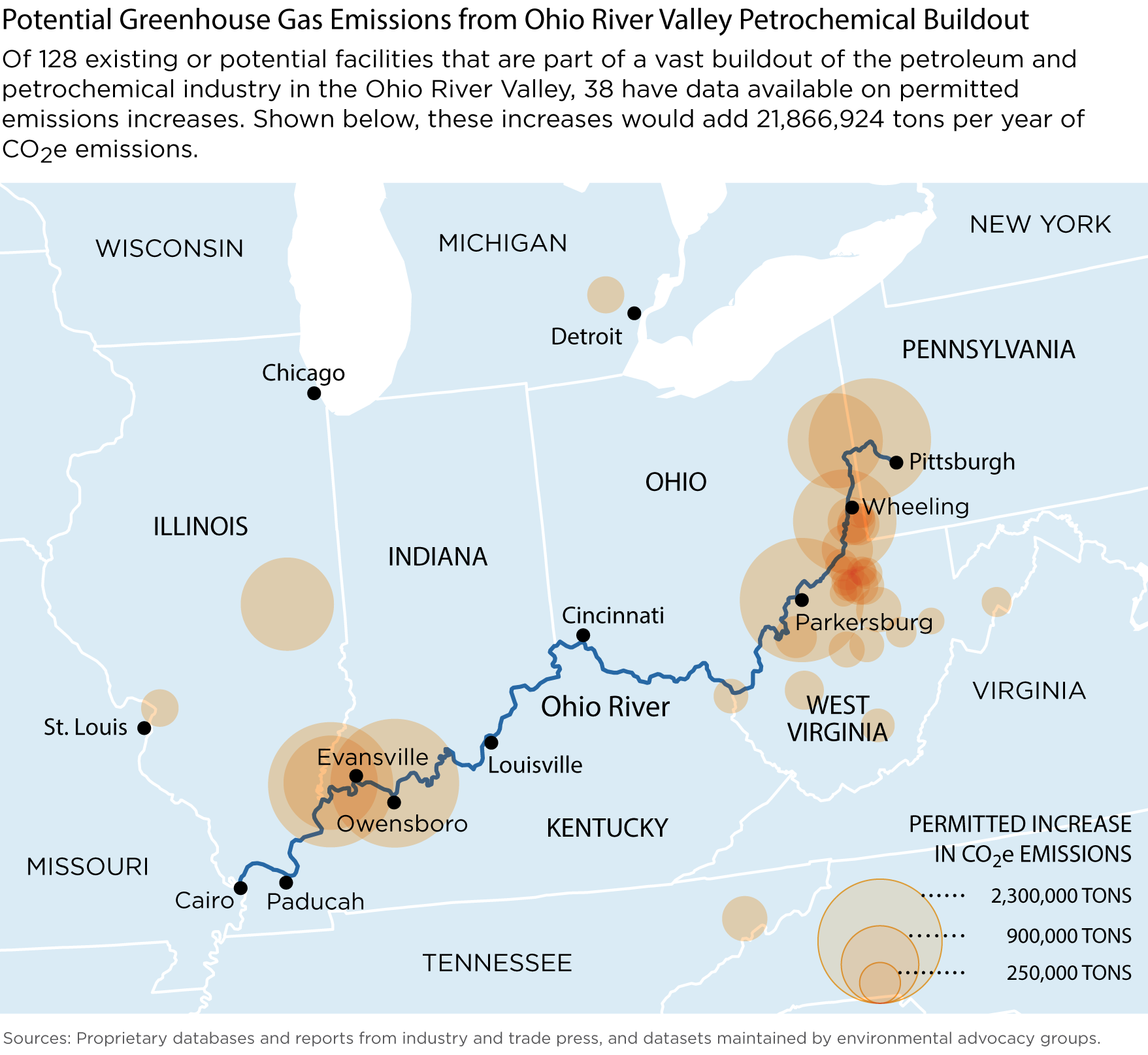The plastics industry plays a major — and growing — role in climate change, according to a report published today by the Center for International Environmental Law (CIEL).
By 2050, making and disposing of plastics could be responsible for a cumulative 56 gigatons of carbon, the report found, up to 14 percent of the world’s remaining carbon budget.
In 2019, the plastics industry is on track to release as much greenhouse gas pollution as 189 new coal-fired power plants running year-round, the report found — and the industry plans to expand so rapidly that by 2030, it will create 1.34 gigatons of climate-changing emissions a year, equal to 295 coal plants.
It’s an expansion that, in the United States, is largely driven by the shale gas rush unleashed by hydraulic fracturing, or fracking.
The petrochemical expansion also comes over the same period of time that international plans to reduce climate change call for rapid reductions in greenhouse gases from all sources — transportation, electricity, and industry.
“Humanity has less than twelve years to cut global greenhouse emissions in half and just three decades to eliminate them almost entirely,” said Carroll Muffett, president of CIEL, citing UN figures. “It has long been clear that plastic threatens the global environment and puts human health at risk. This report demonstrates that plastic, like the rest of the fossil economy, is putting the climate at risk as well.”
“If growth trends continue,” the report concludes, “plastic will account for 20 percent of global oil consumption by 2050.”
The new report, co-authored by Environmental Integrity Project, FracTracker Alliance, Global Alliance for Incinerator Alternatives (GAIA), 5 Gyres, and Break Free From Plastic, looks at how plastic production carries major impacts for the climate as it goes from raw materials tapped by the fossil fuel industries all the way through its ultimate disposal or breakdown in the environment.
From Wellhead to Trash Heap
The new report finds climate problems at each stage.
“The story of plastic’s contribution to climate change really begins at the wellhead,” said Matt Kelso, a manager at FracTracker Alliance, which contributed to the report, “and we can therefore say that a portion of carbon emissions from oil and gas production is attributable to the creation of plastics.”
Annual greenhouse gas emissions for the plastics industry compared to 500 megawatt coal-fired power plants running at full capacity. Credit: 2019 CIEL report, Plastic & Climate: The Hidden Costs of a Plastic Planet
Transforming those raw material into plastic requires massive amounts of energy. On average, the report found, making one ton of plastic created 1.89 metric tons of greenhouse gas pollution.
There are over 300 new petrochemical projects underway in the U.S. alone, most of which will make plastic or plastic additives. “Plastic refining is among the most greenhouse gas-intensive industries in the manufacturing sector — and the fastest growing,” the report finds.
But plastic’s climate impacts don’t end there.
Only 9 percent of plastic is recycled — and while some is landfilled, a growing percentage is burned, either for disposal or for fuel. “Waste incineration, also referred to as Waste-to-Energy, is the primary source of greenhouse gas emissions from plastic waste management, even after considering the electricity that can be generated during the process,” said Doun Moon, a research associate with report co-author GAIA.
The report also describes surprising evidence of how plastic trash in the environment affects the climate. Not only can plastic emit measurable amounts of greenhouse gases as it degrades, but also, the report says, “a small but growing body of research suggests plastic discarded in the environment may be disrupting the ocean’s natural ability to absorb and sequester carbon dioxide.”
All told, the report highlights the growing role that plastic production plays in changing the world’s climate.
“At every moment that we possibly can, we are making conservative, lower-bound estimates,” said lead author Steven Feit. “Setting aside for the moment the health impacts, this massive expansion is really dangerous from a climate perspective.”
Does a ‘Plastic Soup’ Ocean Stop Acting as a Carbon Sink?
Submariner Victor Vescovo recently broke deep sea dive records by touching the bottom of the Mariana Trench at a depth of over 35,850 feet.
There, he found a piece of plastic trash amid multiple previously undiscovered species.
It’s just one sign of how much plastic pollution the world’s oceans now contain.
Microplastics collected from the ocean. Credit: Will Parson/Chesapeake Bay Program, CC BY–NC 2.0
“Every year, more than eight million tonnes of harmful plastic waste end up in the ocean,” U.N. Secretary-General António Guterres said in a May 14 speech in Fuji. “According to one recent study, plastic could outweigh fish in our seas by 2050.”
The CIEL report also highlights how plastic contributes to climate change long after it’s made — and that’s not only when plastic is burned in incinerators.
For one thing, the report notes, recent research reveals that exposing plastic trash to light triggers the release of greenhouse gases from the plastic itself as it breaks down. Polyethylene plastic — the kind that’s mostly used for single-use plastic items — releases methane, ethane, propylene, and ethylene gases.
“This unexpected discovery shows that the degradation and breakdown of plastic represents a previously unrecognized source of greenhouse gases that are expected to increase, especially as more plastic is produced and accumulated in the environment,” CIEL wrote.
But that’s not the only surprising way that plastic — particularly plastic trash that finds its way to the ocean — contributes to climate change.
The oceans have soaked up between 30 and 50 percent of all the carbon dioxide pollution that people have produced since the dawn of the industrial era, the report says.
But there are signs that plastic pollution may be causing a breakdown in the ocean’s ability to act as a carbon sink.
“Phytoplankton take sunlight and they pull in carbon dioxide and they turn it into food, and then get eaten by zooplankton — that’s step one of how the ocean absorbs carbon dioxide,” explained Feit. “There’s evidence mounting that microplastics are interfering with the zooplankton and that chain.”
Plankton plays a little-understood but important role in the ways that the ocean absorbs carbon. For example, a tiny kind of fish known as a lanternfish represent, by mass, half of the fish in the ocean.
Lanternfish eat carbon-rich zooplankton near the sea’s surface and their poop sinks towards the seafloor, keeping that carbon locked away far from the air we breathe. A 2013 study found that lanternfish and similar species sank 30 million tons of carbon a year in the waters off the U.S. West Coast alone.
But as plastic debris breaks down into smaller and smaller bits in the ocean, lanternfish can wind up eating plastic instead of plankton, causing the fish to suffer direct physical harm and chemical poisoning, the LA Times reported in 2017.
And that’s affecting just one of the ways that plankton and the marine food chain directly reduce climate change.
“That [marine food chain] process is 50 percent of the ocean’s ability to absorb carbon,” Feit said.
“Research into these impacts is still in its infancy,” the report concludes, “but early indications that plastic pollution may interfere with the largest natural carbon sink on the planet should be cause for immediate attention and serious concern.”
Plastic Appalachia
This story is part of Fracking for Plastics, a DeSmog investigative series on the proposed petrochemical build-out in the U.S. and the major players involved, along with the environmental, health, and socio-economic implications.
On shore, the plastic industry has major expansion plans worldwide — and particularly in the U.S.
Plastic is currently responsible for less annual pollution than cement, which in 2016 produced 2.2 gigatons of CO2, according to the International Energy Agency — but the plastics industry is poised to grow quickly, CIEL found.
“Industrial sources comprised 40 percent of global greenhouse gas emissions in 2014,” the CIEL report said. “Just four sectors — steel, plastic, cement, and aluminum — account for fully three quarters of these emissions. Of the four sectors, plastic is witnessing the most rapid and sustained growth, and it is projected to have the largest growth in emissions under business-as-usual scenarios.”
“Current plans for rapid expansion of production capacity are concentrated in the United States, China, and the Middle East, but also include expansions of petrochemical capacity in Europe and South America,” the report found.
“In an era when we need to be fighting climate change and reducing emissions, the plastics industry is planning to expand,” said Feit. “In the United States, this is driven by shale gas.”
Demystify the industry jargon with DeSmog’s Field Guide to the Petrochemical and Plastics Industry
Permits for Shell’s Pennsylvania ethane cracker, a massive plastics plant currently under construction, allow it to release 2.25 million tons of greenhouse gases a year.
That means running Shell’s one plastic-making cracker facility for a year could cause more climate-changing pollution than replacing every passenger car registered in Pittsburgh with 2019’s most gas-guzzling full-size SUV, the Jeep Grand Cherokee Trackhawk 4WD, which the U.S. Environmental Protection Agency clocks in at 13 miles per gallon.
And that’s just the 2.25 million tons of direct emissions from one new plastics plant. Today’s report finds that full life-cycle emissions from plastic production worldwide are slated to grow from over 850 million metric tons of greenhouse gases to over 1,340 million metric tons, over 200 times the climate-changing pollution from Shell’s Pennsylvania plant.
Greenhouse gas emissions from planned petrochemical projects along the Ohio River in Appalachia and the Midwest. Credit: 2019 CIEL report, Plastic & Climate: The Hidden Costs of a Plastic Planet
“Of 128 existing or potential facilities that are part of a vast buildout of the petroleum and petrochemical industry in the Ohio River Valley, 38 have data available on permitted emissions increases,” the report found, adding that those 38 projects would add roughly 22 million tons of greenhouse gases to the atmosphere each year, about 10 times the impact of the Shell plant alone.
And that, in turn, means that policy-makers in Appalachia — as well as those on the Gulf Coast — face important decisions on the horizon.
“This is not something that can be just easily turned around once those facilities are built,” said Feit. “Really the surest solution to dealing with the problem of plastics and climate is to reduce plastic production, to keep the fossil fuels in the ground, to move towards eliminating the use of single-use plastics and non-essential plastics.”
Main image: Escape from the vortex. Credit: Richard Black, CC BY 2.0Subscribe to our newsletter
Stay up to date with DeSmog news and alerts










